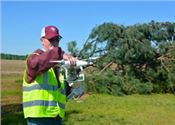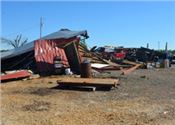|
UAS Technology Helps Assess Tornado Damage
HAMILTON, MISS.
Determining the extent of tornado damage to farms in Monroe County will take weeks, but video shot from flying drones will speed up the process.
Mississippi State University Extension Service personnel have been assisting in relief efforts since the morning after an EF-2 tornado on April 13 damaged more than 140 homes in Hamilton, claiming one life and injuring 19 others.
At the same time, Extension personnel are conducting agricultural damage assessments and assisting producers who suffered property damage from the storm. They will relay this information to the Mississippi Emergency Management Agency.
One component of these assessments relies on unmanned aerial vehicles, also known as drones, to survey affected areas and gather aerial footage of damaged cropland and structures. Louis Wasson, senior Extension associate with the MSU Geosystems Research Institute, oversees the Extension flyovers.
MSU Extension uses unmanned aerial vehicles to assess farm damage after disasters.
“Before each flyover, we overlay a satellite map of the county we’ll be in with the path of the tornado, which we get from the National Weather Service. This helps us determine the altitude and the path the aircraft will take,” Wasson said. “From the ground level, you are walking around a structure and seeing a limited distance. From the air, you can see the damage to the entire structure, and you can also see the extent of where the tornado took all the debris.”
MSU Extension agronomist Charlie Stokes estimated 20 farms were affected in southern Monroe County. Damage includes trees toppled onto fences and sheds, as well as widespread debris littering cropland. Several structures in the tornado’s direct path were destroyed.
“We conducted an assessment April 15 going from farm to farm, but getting this aerial view will help us get more detailed information,” Stokes said. “We have only two row crop farms with heavier damage, but a lot of small farms, cattle farms and horse farms have fences down and so forth. Fortunately, we haven’t had any loss of life with animals.”
Lifelong farmer Danny Holloway’s property was among the hardest hit in Hamilton. His home sustained severe damage; most of its roof was destroyed and is now fortified by blue tarp. Flying debris hit Holloway’s farm equipment.
“The front and side windows are gone in one of the combines, and I noticed the back of it is busted,” he said. “A board went through one of the cotton pickers. I’ve got two tractors that it blew the windows out of and another tractor it busted the window out of the back of it.”
Randall Nevins, MSU Extension coordinator in Monroe County, helped organize a 20-person cleaning crew to remove debris from 190 acres of Holloway’s fields.
“Just looking at the eight or 10 farm-related structures in the line of the tornado, I’d say you have some total losses there,” Nevins said. “You’re going to have to take it all out and put up new structures because those buildings are gone. It’s pretty severe in certain areas. Our farmers are going to have to pick up the pieces, and we’re going to help them try to do that as we move on into the next few weeks.”
Extension will also assist other residents who lost homes or suffered property loss.
“After this first week and initial things are done on the ground, we will help staff the supply distribution points as far as people coming to get supplies,” Stokes said. “We will staff volunteer service centers. It’ll be a lot of helping neighbors clean up. In the weeks to come, we will still be very involved.” ∆

Louis Wasson of the Mississippi State University Extension Service prepares to launch an
unmanned aerial system quadcopter to shoot video of damage from the
April 13 tornado in Hamilton, Mississippi.

Agricultural buildings, equipment and fields in the Hamilton, Mississippi, area received extensive
damage from an EF-2 tornado on April 13, 2019.
Photos by MSU Extension Service/Linda Breazeale
|
|